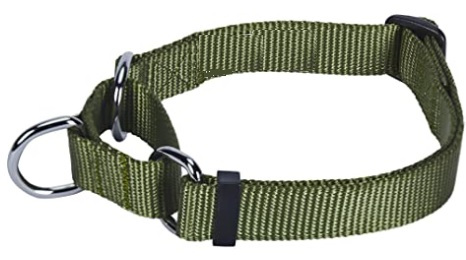Training Collars
There are a number of articles that suggest that a harness is better than a collar. These articles suggest that harnesses disperses pressure over a larger area of the body. That is of course true. However what they don't do is discourage pulling or tugging. They just make it more comfortable, assuming that the harness is correctly fitted and the right size. Whether the harness is attached on the chest or the shoulder blades makes no difference, albeit for small breeds there is some evidence that back attaching harness are preferable since they can be more sensitive to front attaching harnesses. The problem is harness don't teach your dog anything. Like the numerous options of bits for a horse's bridal, there are numerous types of collars and all have a different function related to training.

Leather Roll Collar
For Norwich Terriers we recommend a rolled leather collar for everyday wear. A properly fitted collar allows you to slide two fingers under it, between the dog's neck and the collar. Of course the collar should not be able to be pulled off without undoing it. This collar potentially has some sort of identification tags for your dog (name and telephone number). While you certainly can use this for walking the dog, it is not a training collar.
Training collars are worn for the specific purpose of training. They should not be left on when you are not training. All collars need to be appropriately adjusted to function and fit properly. The simplest of training collars is the Martingale.




Martingale Collars
- Safety First - Martingale collars are difficult to slip out of. Martingale collars should not be left on a dog once training is complete. Although martingale collars are great for everyday walks, the looser design has a slightly higher chance of becoming caught on objects or during play with other dogs. Some professionals recommend only using martingale collars on walks and using an identification collar on your dog so they always have a form of ID on them. Supervision is recommended. Dog’s should never be tethered and left unattended for any period of time while wearing a martingale collar. Do not use with a retractable leash with a martingale collar. The constant tension of the leash will engage the martingale control loop. Martingale collars should be removed before crating your dog.
- Construction - Martingale collars fit loosely on a dog's neck and tighten when it needs to. It has two loops. The first looks like a traditional nylon collar that is adjustable and hangs around the dog’s neck. The second is for control when the leash is attached. This second loop can be either nylon or chain.
. - Sizing - Measure Dog's Neck: Using a soft tape (seamstress tape) measure around your dog’s neck where their collar naturally sits. Pull the tape until it is snug but not tight. You should be able to comfortably put two fingers between the measuring tape and your dog's neck. Note that the head of your dog may be bigger than the neck and of course the Martingale has to slip over the head! Record your measurement. If you do not have a soft tape, use a piece of string and measure around your dog’s neck using the above instructions. Take the string and lay it flat on a smooth surface and use a ruler or tape measure to obtain the measurement. The width of the collar if it is flat should be 1/4" for a puppy and 1/2" for an adult.
Adjusting the Martingale collar - To set the adjustment, pull the collar up to the top of the neck, so it is sitting just behind the ears. To ensure a good fit, you want to adjust it to be snug here, as this is the smallest part of the neck (before going over the head). This will prevent your dog from being able to slip out of the collar.
Once tension is relieved from the collar it should sit comfortably mid-neck and be slightly looser fitting than a flat collar. When in this location, leash attached, and pulled tight the hardware on the control loop should never touch! There should always be two fingers (=2") width of fabric between the hardware.
Note: The control loop on the collar should have enough slack to pull into a symmetrical triangular shape when a leash is attached and pulled. If the hardware at the base of the loop is touching, your collar is too loose. It will form a sharp triangle. If the loop is laying flat against the dog’s neck or forming a flat triangle, the collar is too tight.
- Functioning - When the dog pulls, the collar tightens and will stay snug around the dog’s neck without choking the dog. When the tension is released, the collar loosens again. The action of the Martingale should be pull and release, pull and release. The dog will begin to recognize that when it pulls the collar tightens. When it does not it is loose. You can also tell the dog to slow down with a gentle tug and immediate release on the leash.
- Martingale collars are gentler than choke (or slip) collars or prong collars which makes it an excellent option for puppies and seniors. Unlike the choke or prong collars Martingales don't get tighter and tighter.
- There are also a variety of Martingale collars. Shown in the first photograph is Chain Martingale. The larger loop is heavy duty nylon and second loop is a chain. The chain makes an audible noise for the dog when it tightens. The second loop can also be made of nylon, as seen in the preceding two illustrations.
Many people find that once the training is learned, dogs walk at the heal position more comfortably ... and you may not need this collar at some point!

